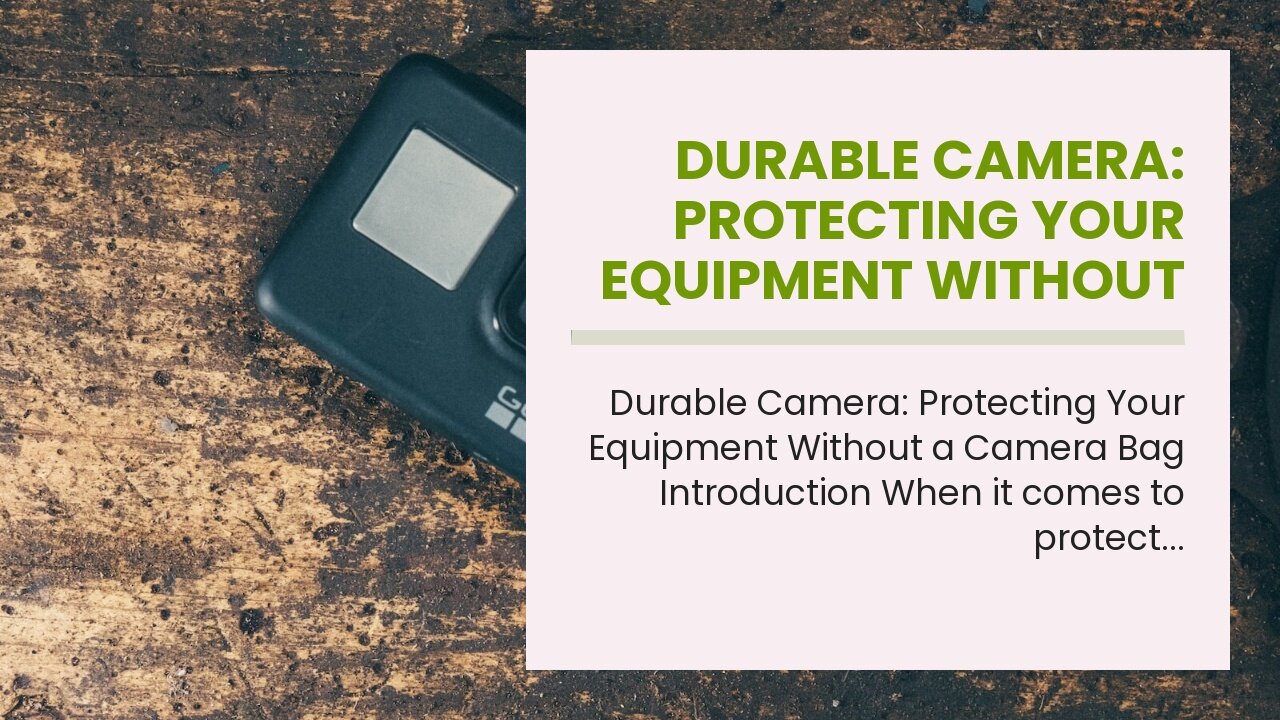Premium Only Content

Durable Camera: Protecting Your Equipment Without a Camera Bag
Durable Camera: Protecting Your Equipment Without a Camera Bag
Durable Camera: Protecting Your Equipment Without a Camera Bag
Introduction
When it comes to protecting your camera, a camera bag is often the go-to solution. However, there may be times when carrying a camera bag is not practical or convenient. In this article, we will explore alternative ways to safeguard your camera without using a camera bag. We’ll discuss the use of camera straps, protective cases, lens caps, and lens filters as effective methods for protecting your camera from damage. Read on to discover how these tools can help you keep your camera safe and secure. Camera Strap: Securely carry...
Durable Camera: Protecting Your Equipment Without a Camera Bag
Introduction
When it comes to protecting your camera, a camera bag is often the go-to solution. However, there may be times when carrying a camera bag is not practical or convenient. In this article, we will explore alternative ways to safeguard your camera without using a camera bag. We’ll discuss the use of camera straps, protective cases, lens caps, and lens filters as effective methods for protecting your camera from damage. Read on to discover how these tools can help you keep your camera safe and secure. Camera Strap: Securely carry your camera around your neck or shoulder.
A camera strap is a simple yet effective way to protect your camera without the need for a camera bag. It allows you to securely carry your camera around your neck or shoulder, keeping it easily accessible while also reducing the risk of accidental drops or damage.
Camera straps come in various designs and materials, so it’s important to choose one that suits your needs and preferences. Look for a strap that is durable, comfortable, and adjustable to ensure a secure fit. Some straps even come with additional features like padding or quick-release mechanisms for added convenience.
When using a camera strap, it’s essential to be mindful of your surroundings. Avoid crowded areas where your camera may be at risk of being bumped or knocked. Be cautious when moving around, especially in tight spaces or near obstacles that could potentially damage your camera.
Additionally, consider investing in a strap with anti-theft features. Some camera straps come with built-in security measures such as slash-proof materials or locking mechanisms to deter potential thieves. These features can provide an extra layer of protection, particularly in busy or high-risk environments.
It’s worth noting that while a camera strap can help protect your camera from accidental drops, it may not provide sufficient protection against extreme weather conditions or impacts. In such cases, it’s advisable to use a camera bag or other protective gear specifically designed for these situations.
In conclusion, a camera strap is a practical and convenient way to protect your camera without the need for a camera bag. It allows you to keep your camera easily accessible while reducing the risk of accidental drops or damage. However, it’s important to be mindful of your surroundings and consider additional protective measures when necessary. Protective Case: Use a durable case to shield your camera from damage.
One effective solution to protect your camera without a camera bag is to use a protective case. A durable case can provide essential protection for your camera, preventing scratches, bumps, and even accidental drops.
When choosing a protective case, opt for one that is specifically designed for your camera model. This ensures a snug fit and maximum protection. Look for a case made from high-quality materials such as hard plastic or rubber, as they offer excellent shock absorption and durability.
Additionally, consider a case that has extra padding or foam inserts to provide an added layer of protection. These inserts can help absorb impact and prevent any potential damage to your camera.
Another important feature to look for is a case with a secure closure mechanism. Whether it’s a zipper, latch, or buckle, make sure it is sturdy and reliable to keep your camera safe and secure.
Furthermore, consider a case that offers weather resistance. This can protect your camera from rain, dust, and other environmental elements that could potentially harm its delicate components.
In recent years, there have been advancements in camera case designs. Some cases now come with built-in shock-absorbing technology, such as air cushions or gel padding, to provide even bette...
-
 2:26:29
2:26:29
vivafrei
16 hours agoEp. 270: MASSIVE SCOTUS WINS! Big Beautiful Bill! New-Scum Sues! Diddy Watch! Big Apple Rot & MORE
129K100 -
 8:38:54
8:38:54
a12cat34dog
10 hours agoTHE *NEW* KRATOS IS EPIC :: God of War (2018) :: FIRST-TIME PLAYING {18+}
24K2 -
 3:12:50
3:12:50
EricJohnPizzaArtist
4 days agoAwesome Sauce PIZZA ART LIVE Ep. #52: GEYCK!
28.7K3 -
 57:30
57:30
RiftTV/Slightly Offensive
6 hours agoTHIS is Where It ALL Went Wrong.. The Rise of NEOCONS | Rift Book Club | B1E2
43.5K23 -
 5:13:57
5:13:57
Barry Cunningham
10 hours agoBREAKING NEWS: SENATE FINAL DEBATE AND DISCUSSION ON BIG BEAUTIFUL BILL
161K95 -
![🔴LIVE | [NIGHTMARE] Assassin's Creed Shadows | PT 5](https://1a-1791.com/video/fww1/30/s8/1/J/V/P/W/JVPWy.0kob-small-LIVE-EXPERT-Assassins-Creed.jpg) LIVE
LIVE
Tekavor
6 hours ago🔴LIVE | [NIGHTMARE] Assassin's Creed Shadows | PT 5
326 watching -
 48:10
48:10
Aztekin59
5 hours ago🔵🔴best weapon?🔴🔵
18.2K2 -
 1:17:14
1:17:14
Sarah Westall
12 hours agoPolitical Rhetoric, War and Open Borders Breeding Dangerous Extremist Cells w/ Carole Lieberman
114K45 -
 1:12:18
1:12:18
Josh Pate's College Football Show
8 hours ago $0.78 earnedCFB’s Team To Beat | Recruiting May Be Back | Better OR Worse In 2025 | Truth About Brent Venables
24.3K -
 43:38
43:38
Patriots With Grit
1 day agoPoverty to Prosecutor; The Food Stamp Warrior | John Deaton
17.6K1